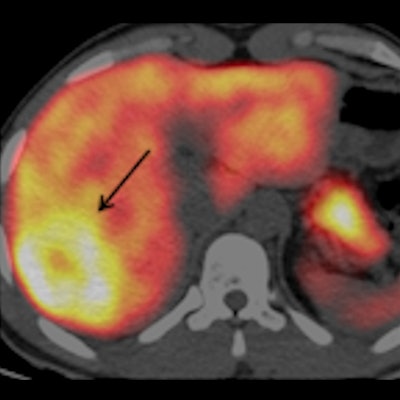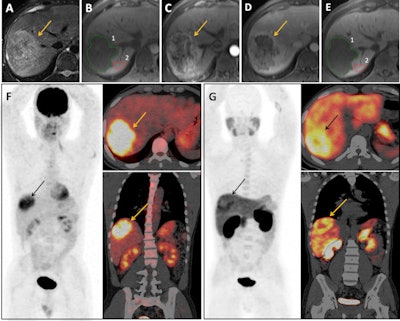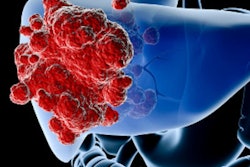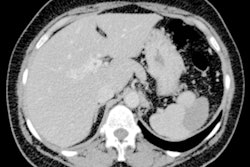
Researchers from near Paris have shown that hepatobiliary MR contrast agent uptake can predict survival in patients with resectable hepatocellular carcinoma (HCC) as well as F-18 FDG PET/CT can. They published their findings on 13 May in European Radiology.
Dr. Sébastien Mulé, PhD, a radiologist from Henri Mondor University Hospital in Créteil, southeast of the capital, and colleagues found that in 32 patients with 35 surgically proven HCCs, the quantitative analysis of the hepatobiliary phase (HBP) tumor enhancement in gadobenate dimeglumine (Gd-BOPTA)-enhanced MRI (lesion-to-liver contrast enhancement ratio, LLCER) accurately identifies moderately to poorly differentiated and/or microvascular invasion (MVI)-positive HCCs.
 MR and dual-tracer PET/CT imaging in a 41-year-old man with poorly differentiated 90-mm HCC lesion in the right liver lobe (region of interest 1). HCC lesion appeared (A) slightly hyperintense on T2-weighted fat-suppressed images, (B) hypointense on T1-weighted precontrast volumetric interpolated breath-hold examination (VIBE) images, (C) hypervascular with heterogeneous arterial enhancement, (D) washout on portal-venous phase, and (E) markedly hypointense on HBP VIBE image compared with adjacent liver parenchyma (region of interest 2), with an LLCER value of -10.28%. F: F-18 FDG PET/CT showed a strong uptake in the lesion, while (G) F-18 FCH PET/ CT showed a peripheral increased activity and a central decreased activity compared with the liver background. Images courtesy of European Radiology.
MR and dual-tracer PET/CT imaging in a 41-year-old man with poorly differentiated 90-mm HCC lesion in the right liver lobe (region of interest 1). HCC lesion appeared (A) slightly hyperintense on T2-weighted fat-suppressed images, (B) hypointense on T1-weighted precontrast volumetric interpolated breath-hold examination (VIBE) images, (C) hypervascular with heterogeneous arterial enhancement, (D) washout on portal-venous phase, and (E) markedly hypointense on HBP VIBE image compared with adjacent liver parenchyma (region of interest 2), with an LLCER value of -10.28%. F: F-18 FDG PET/CT showed a strong uptake in the lesion, while (G) F-18 FCH PET/ CT showed a peripheral increased activity and a central decreased activity compared with the liver background. Images courtesy of European Radiology.Compared with dual-tracer F-18 FDG and F-18 fluorocholine PET/CT, the contrast-enhanced MRI method performed well for the prediction of tumor aggressiveness and recurrence-free survival (RFS), and Gd-BOPTA-enhanced MRI with delayed HBP images deserves consideration as part of presurgery workup in patients with resectable HCC, the authors noted.
"The findings confirm our impressions in clinical routine. Indeed, we noted that HCC without significant enhancement at the hepatobiliary phase had higher histological grades than the other ones. Therefore, we were not surprised that the HBP tumor enhancement may also help predict recurrence-free survival," Mulé told AuntMinnieEurope.com in an email.
However, he added that the strength of that predictive ability surprised the team in part, particularly because F-18 FDG PET/CT is of such well-established prognostic value in patients with HCC.
"PET/CT using F-18 FDG allows the identification of poorly differentiated HCCs at the expense of a relatively lower sensitivity for the detection of well-differentiated HCCs. F-18 FDG has also been shown to negatively correlate with tumor differentiation," the authors wrote, emphasizing that F-18 FDG positivity may help predict both MVI and early recurrence after surgical resection, while PET/CT with radiolabeled choline -- i.e., 11C-acetate or F-18 fluorocholine (F-18 FCH) -- is of great interest to detect well-differentiated HCCs.
Study details
All patients with untreated HCC who underwent F-18 FDG PET/CT as part of workup before liver resection or orthotopic liver transplantation at Henri Mondor University Hospital between October 2013 and January 2018 were considered eligible for the study (n = 71), and patients were included if they also underwent preoperative liver MRI with HBP imaging. A total of 36 people met the inclusion criteria.
All patients underwent Gd-BOPTA-enhanced MRI including delayed HBP images, F-18 FDG PET/CT, and (for 29/32 patients) F-18 FCH PET/CT during the two months prior to surgery. For each lesion, the authors calculated the LLCER on MRI HBP images and the SUVmax tumor-to-liver ratio (SUVT/L) for both tracers. They analyzed and compared the predictive value for aggressive pathological features, including the histological grade and MVI, as well as the RFS.
The area under receiver operating characteristics for the identification of aggressive HCCs on pathology with LLCER, F-18 FDG SUVT/L, and F-18 FCH SUVT/L were 0.92 (95% confidence interval [CI] 0.78, 0.98), 0.89 (95% CI 0.74, 0.97; p = 0.70), and 0.64 (95% CI 0.45, 0.80; p = 0.035). LLCER was identified as an independent predictor of RFS (HR [95% CI] = 0.91 [0.84, 0.99], p = 0.022). LLCER − 4.72% or less also accurately predicted moderate to poor differentiation grade (sensitivity = 100%, specificity = 92.9%) and MVI (sensitivity = 93.3%, specificity = 60%) and identified patients with poor RFS after surgical resection (p = 0.030).
After surgical resection for HCC, patients with an LLCER of -4.72% or less had significantly poorer recurrence-free survival than patients with an LLCER superior to -4.72%, according to the authors.
"HBP tumor enhancement after Gd-BOPTA injection may help identify aggressive HCC pathological features, and patients with reduced recurrence-free survival after surgical resection," they wrote.
Impact of research
Based on the study findings, senior author and radiologist Prof. Alain Luciani and the rest of the team have changed their routine practice by integrating Gd-BOPTA-enhanced MRI with delayed HBP images as part of presurgery workup in all patients with resectable HCC.
 Dr. Sébastien Mulé, PhD, from Henri Mondor University Hospital in Créteil.
Dr. Sébastien Mulé, PhD, from Henri Mondor University Hospital in Créteil."PET/MRI with F-18 FDG is now performed in our institution as part of HCC pretreatment workup," Mulé noted. "Improving lesion characterization and prognostic prediction by systematically performing acquisitions at the hepatobiliary phase may be an interesting next step. Further studies will evaluate whether hepatobiliary MR contrast agent uptake may help optimize therapeutic management strategy in patients with HCC."
Staff at the Henri Mondor University Hospital have been and still are involved in the care of COVID-19 patients, and the pandemic has had a significant impact on the organization and the clinical activity of the radiology department, he said.
"Notably, the management of patients with HCC was significantly altered, as patients were more likely to wait before they consult, and thus to present with more advanced stages of disease," Mulé added.




















